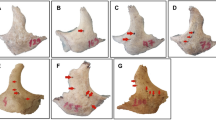Abstract
Background
The foramen of Vesalius (FV) is located in the greater wing of the sphenoid bone between the foramen ovale (FO) and the foramen rotundum in an intracranial view. The FO allows the passage of the mandibular branch of trigeminal nerve, which is the target of the trigeminal radiofrequency rhizotomy.
Objective
We analyzed its location, morphology, morphometry and interrelation among other foramina.
Materials and methods
400 macerated adult human skulls were examined. A digital microscope (Dino-Lite plus®) was used to capture images from the FV. A digital caliper was used to perform the measurements of the distance between the FV and other foramina (FO, foramen spinosum and the carotid canal) in an extracranial view of the skull base.
Results
In the 400 analyzed skulls, the FV was identified in 135 skulls (33.75%) and absent on both sides in 265 skulls (66.25%). The FV was observed present bilaterally in 15.5% of the skulls. The incidence of unilateral foramen was 18.25% of the skulls of which 7.75% on right side and 10.5% on left side. The diameter of the FV was measured and we found an average value of 0.65 mm, on right side 0.63 mm and on the left side 0.67 mm. We verified that positive correlations were statistically significant among the three analyzed distances.
Conclusions
This study intends to offer specific anatomical data with morphological patterns (macroscopic and mesoscopic) to increase the understanding of the FV features as frequency, incidence and important distances among adjacent foramina.



Similar content being viewed by others
References
Berge JK, Bergman RA (2001) Variations in size and in symmetry of foramina of the human skull. Clin Anat 14(6):406–413
Bergman RA, Afifi AK, Miyauchi R (1995) Illustrated encyclopedia of human anatomic variation: Opus V: Skeletal Systems: Cranium
Boyd GI (1930) Emissary foramina of cranium in man and the anthropoids. J Anat 65:108–121
Ginsberg LE, Pruett SW, Chen MY, Elster AD (1994) Skull base foramina of the middle cranial fossa: reassessment of normal variation with high-resolution CT. Am J Neuroradiol 15(2):283–291
Gupta N, Ray B, Ghosh S (2005) Anatomic characteristics of foramen Vesalius. Kathmandu Univ Med J 3(2):155–158
Gusmão S, Magaldi M, Arantes A (2003) Trigeminal radiofrequency rhizotomy for the treatment of trigeminal neuralgia: results and technical modification. Arq Neuropsiquiatr 61(2B):434–440
Hinteregger M, Zschiegner F, Lirk P, Ladner E, Goeschl A, Gaber O, Moser P, Lorenz I, Kolbitsch C (2004) A new guidance device facilitates percutaneous puncture of the foramen ovale in human cadavers. Can J Anaesth 51(10):990–992
Kaplan M, Erol FS, Ozveren MF, Topsakal C, Sam B, Tekdemir I (2007) Review of complications due to foramen ovale puncture. J Clin Neurosci 14(6):563–568
Keskil S, Gözil R, Calgüner E (2003) Common surgical pitfalls in the skull. Surg Neurol 59(3):228–231 (discussion 231)
Kim DI, Kim HS (1995) High resolution CT evaluation on the morphologic characteristics and variations of foramen ovale and adjacent foramina in the skull base. J Kor Radiol Soc 33(1):43–48
Kocaogullar Y, Avci E, Fossett D, Caputy A (2003) The extradural subtemporal keyhole approach to the sphenocavernous region: anatomic considerations. Minim Invas Neurosurg 46(2):100–105
Kodama K, Inoue K, Nagashima M, Matsumura G, Watanabe S, Kodama G (1997) Studies on the foramen Vesalius in the Japanese juvenile and adult skulls. Hokkaido Igaku Zasshi 72(6):667–674
Lang J (1983) Clinical anatomy of the head, neurocranium, orbit and craniocervical region. Springer, Berlin
Lanzieri CF, Duchesneau PM, Rosenbloom SA, Smith AS, Rosenbaum AE (1988) The significance of asymmetry of the foramen of Vesalius. Am J Neuroradiol 9(6):1201–1204
Liu M, Wu CY, Liu YG, Wang HW, Meng FG (2005) Three-dimensional computed tomography-guided radiofrequency trigeminal rhizotomy for treatment of idiopathic trigeminal neuralgia. Chin Med Sci J 20(3):206–209
Lunsford LD, Niranjan A, Kondziolka D (2007) Surgical management options for trigeminal neuralgia. J Kor Neurosurg Soc 41:359–366
Nemzek WR, Brodie HA, Hecht ST, Chong BW, Babcook CJ, Seibert JA (2000) MR, CT, and plain film imaging of the developing skull base in fetal specimens. Am J Neuroradiol 21(9):1699–1706
Ramalho AJC, Sousa-Rodriguez CF, Rodas PMM, Lins CJP, De Lima RL, Almeida ETDL, Neto JABS (2007) A incidência e as relações morfométricas do forame emissário do esfenóide em crânios humanos. Int J Morphol 25(1):147
Reymond J, Charuta A, Wysocki J (2005) The morphology and morphometry of the foramina of the greater wing of the human sphenoid bone. Folia Morphol (Warsz) 64(3):188–193
Sekimoto K, Koizuka S, Saito S, Goto F (2005) Thermogangliolysis of Gasserian ganglion under computed tomography fluoroscopy. J Anesth 19(2):177–179
Shapiro R, Robinson F (1967) The foramina of the middle fossa: a phylogenetic, anatomic and pathologic study. Am J Roentgenol 101:779–794
Sindou M, Keravel Y, Abdennebi B, Szapiro J (1987) Neurosurgical treatment of trigeminal neuralgia. Direct approach or percutaneous method? Neurochirurgie 33(2):89–111
Sweet WH, Poletti CE (1988) Complications of percutaneous rhizotomy and microvascular decompression operations for facial pain. In: Schmideck HH, Sweet WH (eds) Operative neurosurgical techniques: indication, methods, and results. Grune and Straton, Orlando, pp 1139–1144
Vesalius A (1543) De humani corporis fabrica libri septem. Bruxelle, Reprint
Williams PL, Bannister LH, Martin MM et al (1995) Gray’s anatomy, 38th edn. Churchill Livingstone, London, pp 425–736
Wysocki J, Reymond J, Skarżyński H, Wróbel B (2006) The size of selected human skull foramina in relation to skull capacity. Folia Morphol 65(4):301–308
Acknowledgments
The authors thank Dr. Ricardo Smith (Unifesp/Brazil).
Author information
Authors and Affiliations
Corresponding author
Rights and permissions
About this article
Cite this article
Shinohara, A.L., de Souza Melo, C.G., Silveira, E.M.V. et al. Incidence, morphology and morphometry of the foramen of Vesalius: complementary study for a safer planning and execution of the trigeminal rhizotomy technique. Surg Radiol Anat 32, 159–164 (2010). https://doi.org/10.1007/s00276-009-0562-3
Received:
Accepted:
Published:
Issue Date:
DOI: https://doi.org/10.1007/s00276-009-0562-3




